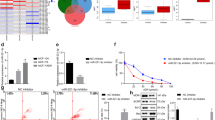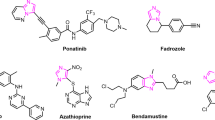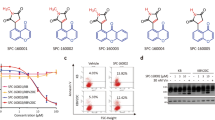Abstract
Miltefosine (hexadecylphosphocholine) is used for topical treatment of breast cancers. It has been shown previously that a high percentage of breast carcinomas express MDR1 or MRP. We investigated the sensitivity of MDR1-expressing cells to treatment with miltefosine. We show that cells overexpressing MDR1 (NCI/ADR-RES, KB-8-5, KB-C1, CCRF/VCR1000, CCRF/ADR5000) were less sensitive to miltefosine treatment when compared to the sensitive parental cell lines. HeLa cells transfected with MDR1 exhibited resistance to the compound, indicating that expression of this gene is sufficient to reduce the sensitivity to miltefosine. The resistance of MDR1-expressing cells to miltefosine was less pronounced than that to adriamycin or vinblastine. Expression of MDR2 did not correlate with the resistance to miltefosine. As shown by a fluorescence quenching assay using MIANS-labelled P-glycoprotein (PGP), miltefosine bound to PGP with a Kd of approximately 7 μM and inhibited PGP-ATPase activity with an IC50 of approximately 35 μM. Verapamil was not able to reverse the resistance to miltefosine. Concentrations of miltefosine up to approximately 60 μM stimulated, whereas higher concentrations inhibited the transport of [3H]-colchicine with an IC50 of approximately 297 μM. Binding studies indicated that miltefosine seems to interact with the transmembrane domain and not the cytosolic nucleotide-binding domain of PGP. These data indicate that expression of MDR1 may reduce the response to miltefosine in patients and that this compound interacts with PGP in a manner different from a number of other substrates. © 2001 Cancer Research Campaign
Similar content being viewed by others
Article PDF
Change history
16 November 2011
This paper was modified 12 months after initial publication to switch to Creative Commons licence terms, as noted at publication
References
Abulrob AG and Gumbleton M (1999) Transport of phosphatidylcholine in MDR3-negative epithelial cell lines via drug-induced MDR1 P-glycoprotein. Biochem Biophys Res Commun 262: 121–126
Akiyama S, Fojo A, Hanover JA, Pastan I and Gottesman MM (1985) Isolation and genetic characterization of human KB cell lines resistant to multiple drugs. Somatic Cell Mol Genet 11: 117–126
Berdel WE (1991) Membrane-interactive lipids as experimental anticancer drugs. Br J Cancer 64: 208–211
Brachwitz H and Vollgraf C (1995) Analogs of alkyllysophospholipids: chemistry, effects on the molecular level and their consequences for normal and malignant cells. Pharmacol Ther 66: 39–82
Cardarelli CO, Aksentijevich I, Pastan I and Gottesman MM (1995) Differential effects of P-glycoprotein inhibitors on NIH3T3 cells transfected with wild-type (G185) or mutant (V185) multidrug transporters. Cancer Res 55: 1086–1091
Choi K, Chen C, Kriegler M and Roninson IB (1988) An altered pattern of cross-resistance in multidrug resistant human cells results from spontaneous mutations in the mdr1 (P-glycoprotein) gene. Cell 53: 519–529
Conseil G, Baubichon-Cortay H, Dayan G, Jault J-M, Barron D and Di Pietro A (1998) Flavonoids: a class of modulators with bifunctional interactions at vicinal ATP-and steroid-binding sites on mouse P-glycoprotein. Proc Natl Acad Sci USA 95: 9831–9836
Doige CA and Sharom FJ (1992) Transport properties of P-glycoprotein in plasma membrane vesicles from multidrug-resistant Chinese hamster ovary cells. Biochim Biophys Acta 1109: 161–171
Doige CA, Yu X and Sharom FJ (1992) ATPase activity of partially purified P-glycoprotein from multidrug-resistant Chinese hamster ovary cells. Biochim Biophys Acta 1109: 149–160
Doyle AL, Yang W, Abruzzo LV, Krogmann T, Gao Y, Rishi AK and Ross DG (1998) A multidrug resistance transporter from MCF-7 breast cancer cells. Proc Natl Acad Sci USA 95: 15665–15670
Fu D, Shi Z and Wang Y (1999) Bcl-2 plays a key role instead of mdr1 in the resistance to hexadecylphosphocholine in human epidermoid tumor cell line KB. Cancer Lett 142: 147–153
Goldie JH and Coldman AJ (1984) The genetic origin of drug resistance in neoplasms: implications for systemic therapy. Cancer Res 44: 3643–3653
Gottesman MM and Pastan I (1993) Biochemistry of multidrug resistance mediated by the multidrug transporter. Annu Rev Biochem 62: 385–427
Hilgard P, Klenner T, Stekar J and Unger C (1993) Alkylphosphocholines: a new class of membrane-active anticancer agents. Cancer Chemother Pharmacol 32: 90–95
Himmelmann AW, Danhauser-Riedl S, Steinhauser G, Busch R, Modest EJ, Noseda A, Rastetter J, Vogler WR and Berdel WE (1990) Cross-resistance pattern of cell lines selected for resistance towards different cytotoxic drugs to membrane-toxic phospholipids in vitro. Cancer Chemother Pharmacol 26: 437–443
Hofmann J, Utz I, Spitaler M, Hofer S, Rybczynska M, Beck WT, Herrmann DBJ and Grunicke H (1997) Resistance to the new anti-cancer phospholipid ilmofosine (BM 41 440). Br J Cancer 76: 862–869
Kane SE, Reinhard DH, Fordis MC, Pastan I and Gottesman MM (1989) A new vector using the human multidrug resistance gene as a selectable marker enables overexpression of foreign genes in eukaryotic cells. Gene 84: 439–446
Kim CH, Gollapudi S, Lee T and Gupta S (1997) Altered expression of the genes regulating apoptosis in multidrug resistant human myeloid leukemia cell lines overexpressing MDR1 or MRP gene. Int J Oncol 11: 945–950
Kimmig A, Gekeler V, Neumann M, Frese G, Handgretinger R, Kardos G, Diddens H and Niethammer D (1990) Susceptibility of multidrug-resistant human leukemia cell lines to human interleukin 2-activated killer cells. Cancer Res 50: 6793–6799
Lautier D, Canitrot Y, Deeley RG and Cole SPC (1996) Multidrug resistance mediated by the multidrug resistance protein (MRP) gene. Biochem Pharmacol 52: 967–977
Ling V and Thompson LH (1974) Reduced permeability in CHO cells as a mechanism of resistance to colchicine. J Cell Physiol 83: 103–116
Liu R and Sharom FJ (1996) Site-directed fluorescence labeling of P-glycoprotein on cysteine residues in the nucleotide binding domains. Biochemistry 35: 11865–11873
Mosman T (1983) Rapid colorimetric assay for cellular growth and survival: application to proliferation and cytotoxicity assays. J Immunol Methods 65: 55–63
Noonan KE, Beck C, Holzmayer TA, Chin JE, Wunder JS, Andrulis IL, Gazdar AF, Willman CL, Griffith B, Von Hoff DD and Roninson IB (1990) Quantitative analysis of MDR1 (multidrug resistance) gene expression in human tumors by polymerase chain reaction. Proc Natl Acad Sci USA 87: 7160–7164
Romsicki Y, Sharom FJ (2001) Phospholipid flippase activity of the reconstituted P-glycoprotein multidrug transporter. Biochemistry (accepted)
Ruetz S and Gros P (1994) Phosphatidylcholine translocase: a physiological role for the mdr2 gene. Cell 77: 1071–1081
Safa AR, Stern RK, Choi K, Agresti M, Tamai I, Mehta ND and Roninson IB (1990) Molecular basis of preferential resistance to colchicine in multidrug-resistant human cells conferred by Gly-185-Val-185 substitution in P-glycoprotein. Proc Natl Acad Sci USA 87: 7225–7229
Scheffer GL, Winjgaard PLJ, Flens MJ, Izquierdo MA, Slovak ML, Pinedo HM, Meijer CJLM, Clevers HC and Scheper RJ (1995) The drug resistance-related protein LRP is the human major vault protein. Nature Med 1: 578–582
Shapiro AB and Ling V (1997) Positively cooperative sites for drug transport by P-glycoprotein with distinct drug specificities. Eur J Biochem 250: 130–137
Shapiro AB, Fox K, Lam P and Ling V (1999) Stimulation of P-glycoprotein-mediated drug transport by prazosin and progesterone – Evidence for a third drug-binding site. Eur J Biochem 259: 841–850
Sharom FJ (1997) The P-glycoprotein efflux pump: how does it transport drugs?. J Membr Biol 160: 161–175
Sharom FJ, Yu X and Doige CA (1993) Functional reconstitution of drug transport and ATPase activity in proteoliposomes containing partially purified P-glycoprotein. J Biol Chem 268: 24197–24202
Sharom FJ, DiDiodato G, Yu X and Ashbourne KJ (1995) Interaction of the P-glycoprotein multidrug transporter with peptides and ionophores. J Biol Chem 270: 10334–10341
Sharom FJ, Yu X, DiDiodato G and Chu JWK (1996) Synthetic hydrophobic peptides are substrate for P-glycoprotein and stimulate drug transport. Biochem J 320: 421–428
Sharom FJ, Liu R and Romsicki Y (1998a) Spectroscopic and biophysical approaches for studying the structure and function of the P-glycoprotein multidrug transporter. Biochem Cell Biol 76: 695–708
Sharom FJ, Lu P, Liu R and Yu X (1998b) Linear and cyclic peptides as substrates and modulators of P-glycoprotein: peptide binding and effects on drug transport and accumulation. Biochem J 333: 621–630
Sharom FJ, Liu R, Romsicki Y and Lu P (1999) Insights into the structure and substrate interactions of the P-glycoprotein multidrug transporter from spectroscopic studies. Biochim Biophys Acta 1461: 327–345
Smit JJ, Schinkel AH, Oude Elferink RP, Groen AK, Wagenaar E, van Deemter L, Mol CA, Ottenhoff R, van der Lugt NM, van Roon MA, van der Valk MA, Offerhaus GJA, Berns AJM and Borst P (1993) Homozygous disruption of the murine mdr2 P-glycoprotein gene leads to a complete absence of phospholipid from bile and to liver disease. Cell 75: 451–462
Smyth MJ, Drasovskis E, Sutton VR and Johnstone RW (1998) The drug efflux protein, P-glycoprotein, additionally protects drug-resistant tumor cells from multiple forms of caspase-dependent apoptosis. Proc Natl Acad Sci USA 95: 7024–7029
Spitaler M, Utz I, Hilbe W, Hofmann J and Grunicke HH (1998) PKC-independent modulation of multidrug resistance in cells with mutant (V185) but not wild-type (G185) P-glycoprotein by bryostatin 1. Biochem Pharmacol 56: 861–869
Thorgeirsson SS, Silverman JA, Gant TW and Marino PA (1991) Multidrug resistance gene family and chemical carcinogenesis. Pharmacol Ther 49: 283–292
Trock B, Leonessa JF and Clarke R (1997) Multidrug resistance in breast cancer: a meta-analysis of MDR1/Pgp170 expression and its possible functional significance. J Natl Cancer Inst 89: 917–931
Vo QD and Gruol DJ (1999) Identification of P-glycoprotein mutations causing a loss of steroid recognition and transport. J Biol Chem 274: 20318–20327
Author information
Authors and Affiliations
Rights and permissions
From twelve months after its original publication, this work is licensed under the Creative Commons Attribution-NonCommercial-Share Alike 3.0 Unported License. To view a copy of this license, visit http://creativecommons.org/licenses/by-nc-sa/3.0/
About this article
Cite this article
Rybczynska, M., Liu, R., Lu, P. et al. MDR1 causes resistance to the antitumour drug miltefosine. Br J Cancer 84, 1405–1411 (2001). https://doi.org/10.1054/bjoc.2001.1776
Received:
Revised:
Accepted:
Published:
Issue date:
DOI: https://doi.org/10.1054/bjoc.2001.1776
Keywords
This article is cited by
-
Thermodynamic behavior of breast cancer cell lines after miltefosine and cisplatin treatment
Journal of Thermal Analysis and Calorimetry (2022)
-
Intestinal Absorption of Miltefosine: Contribution of Passive Paracellular Transport
Pharmaceutical Research (2007)
-
New Insights into the Drug Binding, Transport and Lipid Flippase Activities of the P-Glycoprotein Multidrug Transporter
Journal of Bioenergetics and Biomembranes (2005)



